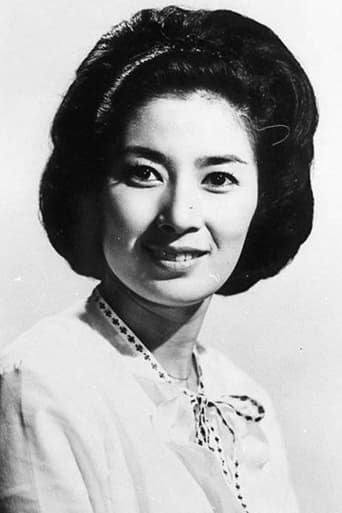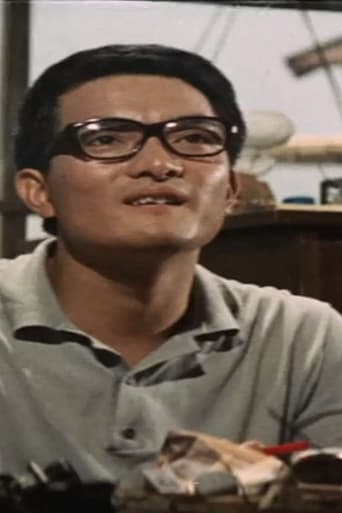Solemplex
To me, this movie is perfection.
Wordiezett
So much average
filippaberry84
I think this is a new genre that they're all sort of working their way through it and haven't got all the kinks worked out yet but it's a genre that works for me.
Darin
One of the film's great tricks is that, for a time, you think it will go down a rabbit hole of unrealistic glorification.
JLRVancouver
'Gorath' is a super-massive stellar core careening through the solar system on a collision course with Earth and our only hope is to push our planet out of the way. While not really a scientifically sound premise or production, Gorath is much 'harder' science fiction than Toho's monster films, with characters discussing issues such as gravity, orbits, thrust requirements for moving the Earth etc., as they count down to what may be Doomsday. As 1960's tokusatsu go, the movie has great design and production values, especially the miniature sets, the vehicles (the VTOL planes are quite clever), the 'disaster scenes', and the 'outer space' segments. There are some pacing problems (we are treated to a helicopter tour of Japan while a bunch of astronauts sing), an unnecessary side plot involving an astronaut with amnesia, and, most egregiously, a gratuitous kaiju in the form of an immense walrus* (allegedly inserted against director Ishiro Honda's wishes). The walrus, "Maguma", is a one-timer in Toho's kaiju zoo, not evening earning a cameo in the multi-monster epics "Destroy All Monsters" (1968) and "Final Wars" (2004), which is just as well as the suit is not very convincing and looks jarringly out of place compared to the meticulously detailed models of "Operation South Pole", Earth's final hope. While the special effects in science fiction films of this vintage cannot compare with modern CGI (1969's "2001, A Space Odyssey" being an exception), Gorath is a fun, creative and imaginative film that showcases the talent of the Toho's production team in the 1960's and is well worth watching. *The walrus scenes are cut from the dubbed American release of the film, my comments pertain to an English-subtitled Japanese version, which is worth finding if you want to view the entire film.
henri sauvage
"Gorath" is the last, and by some standards the best, of Inoshiro Honda's "space trilogy" of the late 50s/early 60s.Once again, Honda explores the theme of humankind forced to work together against an extraterrestrial adversary. Only this time we're not facing aliens, but something far more deadly, and utterly implacable: a runaway stellar remnant which for some unexplained reason the authorities name "Gorath". Composed of collapsed matter -- which gives it a mass and gravitational pull far out of proportion to its relatively small size -- even a near-miss (in cosmic terms) would render the Earth uninhabitable.It can't be blown up, and there's no way to change its orbit. Obviously, there's nothing left to do but build a bunch of enormous hydrogen fusion rocket engines at the South Pole and move our planet out of its way. (If there's one thing you could never fault Honda for, it's a lack of imagination, even if the physics of the thing are completely impossible.) This is definitely a more somber and slower-paced outing than those two earlier films. Instead of the almost non-stop skirmishing between the Earth forces and dastardly aliens which typified the previous films in the trilogy, the drama lies in humanity's desperate race against time, to save itself with the biggest, most complex feat of engineering ever attempted. So, despite its typically energetic Akira Ifukube score, this one naturally lacks some of the naive charm and relentless drive which distinguished the colorfully juvenile "The Mysterians" and "Battle in Outer Space".What makes this film a standout in its own right, though, is that it contains what might just be the Tsuburaya team's most impressive miniature work ever. You must see this in letterbox, in the original Japanese version, to fully appreciate its scope and grandeur, specially the extended montage depicting the rocket motors' construction at the South Pole. (I believe Honda must have been heavily influenced here by the "remaking of Everytown" sequence in 1937's "Things to Come", even down to the musical theme Ifukube composed for it.) Plus there are nicely executed spaceship and space station models and effects, not to mention some fairly imaginative visuals as Gorath careens through the solar system. (The original version comes with a bonus: the totally unnecessary -- to the plot, anyway -- giant prehistoric walrus.) The earthquake and tsunami sequence which takes place as Gorath makes its closest approach to Earth is, in fact, rather eerie to watch in the light of recent events.Unfortunately, though, the tsunami -- along with a few seconds of recycled footage of a landslide from "The Mysterians" -- are about the only glimpses we're ever given of Gorath's devastating effects. So even with what must have been a substantially bigger budget than either of the two preceding films in the trilogy, the ending feels rushed, and a bit of a letdown.Regardless of my nit-picking, "Gorath" is still well worth watching, a truly unique movie both for this director, and in its own apocalyptic genre.
xerses13
GORATH/Yosei Gorasu (1962) is TOHOs' take on the 'end of the world' disaster film. That theme seems to be near and dear to every motion picture company in the world sometime or another. Whether a localized disaster or universal Armageddon there's boffo box-office in seeing masses of humanity and their works trashed.The film is made too the level of the limited budget and technical skills of the Japanese film industry of the time. That did not make it a poor film though and the subject was treated with respect. Unlike TOHOs' next fantasy film KING KONG vs GODZILLA/Kingu Kongu tai Gojira (1962) where the slide to camp kiddie fare began.THE NUTS; GORATH which can be best described as a Red Dwarf Star is on a collision course with the Earth. The solution, move the Earths orbit North by 400,000 Kilometers (est.280,000 Miles) which would tilt the orbital plane allowing GORATH to pass. How to do it, lots of Fusion Rockets at the South Pole. The main focus of the movie is the building of the Rockets and scenes of major destruction with GORATHs' passing. In addition there is a bonus Monster/Kaiju of a Giant Walrus that looks like stuffed foam rubber and which was eliminated from U.S.A. release.Though not up to THE MYSTERIANS/Chikyu Boeigun (1957) it's as good as BATTLE IN OUTER SPACE/Uchu daisenso (1959). It is the last of the 'Space Operas' from 'The Golden Age' of the Japanese fantasy film. Films that we find more enjoyable then those made in the Eastern Block countries and laterally Italy. It is best to get the original Japanese release versions of these films. They are more coherent in their original edit and dubbing translation.
hideyotsuburaya
U.S. version GORATH editor @Brenco Pictures was none other than KENNETH WANNBERG in his 'salad days', who's of course gone onto be John Williams right-hand man as music editor on STAR WARS, et. al. (an interesting thematic link). I once asked him about it and he said way back then he carried around a print of GORATH in his car trunk as part of his resume.Certain U.S. release advertising states "in stereophonic sound", which I can assure you is domestic wishful thinking (the same applies to Brenco Pictures distributed THE HUMAN VAPOR). Not so the original Japanese release, which can boast (authentic) stereo track.Frederick S. Clarke, late CINEFANTASTIQUE mag. editor/publisher, said he thought GORATH contained the best Toho Co. special-effects work of all their outer-space films. I agree.Stan Timmons (BATTLESTAR GALLACTICA in print) remarked he thought the dubbed-voices in the English GORATH version sound all like old Rocky & Bulwinkle cartoons. Well yes, they do.And GORATH actor George Farness, mentioned in another viewer comment, not only has a major role in THE LAST VOYAGE, but also narrates that film.Director Ishiro Honda did GORATH immediately before KING KONG VS. GODZILLA in 1962. Yes this truly was the golden age of TOHO. But from what I've heard in the past this film's not highly regarded by fans in his home country.







